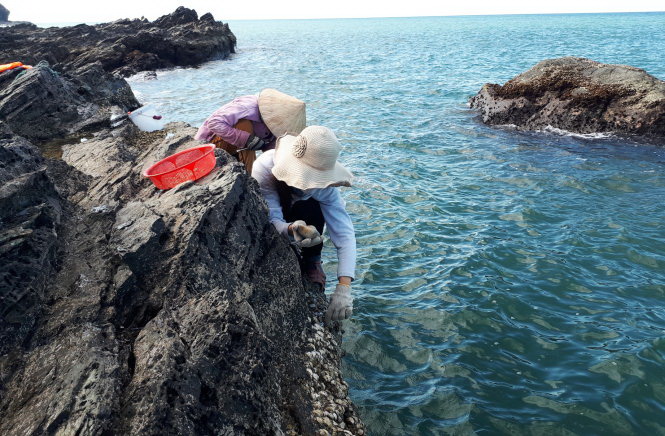Scavengers can easily be ‘swallowed’ by waves and swept away by the sea
Groups of women in a province in central Vietnam, including the elderly, have toiled hard at the risk of their own lives in order to scavenge for barnacles and eke out a meager living for years.
Under the blazing noon sun recently, dozens of women could be seen sweating atop razor-sharp embankments that dot Ban Than Lagoon, nestled in Tam Hai Commune, Nui Thanh District, Quang Nam Province.
Perched precariously, they painstakingly bore into the hard rock surface using iron awls in the hope of gathering the barnacles that perforate and cling to the surface.
Pham Thi Lien, 79, slowly plodded toward the rocks, where the receding tide exposed a surface riddled with bores.
Her routine involves pounding hard on the iron awl with a stone so that it penetrates the barnacles’ rigid shells encrusted on the rock surface.
As the shells break open, Lien slowly pulls out the barnacle’s soft un-segmented body with great care.
The septuagenarian has been on the job for around fifty years.
She recalled the old times, when men would go fishing and women would go barnacle-scavenging for additional income.
“Ban Than Lagoon is has the much-coveted ‘milk’ barnacles. We scour for the living mollusks whose shells are shut tight. It’s not an easy job,” Lien said.
She typically manages one or two bowlfuls of barnacles each afternoon, which she sells to restaurants for VND40,000-60,000 (US$2-3).
The money is barely enough for herself and her husband to get by.
The relatively level outcrop is frequented mainly by the elderly ‘hunters’, while those younger ‘mine’ more precarious sites such as Dai (Long) Beach where there are more barnacles with firmer flesh and more ‘milk’.
Nearly a dozen women could be seen perched on treacherous ledges along Dai Beach that afternoon.
They were sitting on the ledges, some 10 meters above sea level, without a single fulcrum or back rest, meaning the chances of falling into the sea remained high.
Several brought along lifebuoys and life vests in the event that they actually tumble into the sea.
Tran Thi Loi, 47, revealed that they had no choice as restaurants purchase the barnacles which abound here for higher prices thanks to their firmer meat and higher ‘milk’ volume.
She explained that barnacle scavenging depends heavily on the ebb and flow of tides and sea conditions.
On days when the sea is calm, they can scrape up to five bowlfuls, or nearly one kilogram of the bivalves between from around 11:00 am each day, when the tides recede, revealing the barnacle-covered rocks.
The taxing routine earns these weather-beaten women, whose husbands are usually fishermen working away from home, VND120,000-140,000 ($5-6) each afternoon.
“Sea barnacles generally boast better flesh than farm-raised ones and thus fetch double the price. The mollusks breed and thrive during the sunny months, or between March and August, so we try to make the most of this time,” Loi added.
The number of female barnacle scavengers in Thuan An Hamlet has dropped to around 30.
The job, which requires meticulousness and dexterity, is mostly done by women.
Apart from Lien, several other foragers, now in their 70s, have been on the job for dozens of years.
Despite the ever present hazards, the women have no choice but to toil hard and sell their hard-earned catch for income that pays for their children’s education and puts food on their family’s table.
Vo Thi Minh Phuong, 30, was the youngest amongst the women.
She switched from an alpine life to a coastal livelihood after getting married to a local man more than 10 years ago.
“We often have backaches and neck pain and even have our limbs slashed by the pointed rocks. Sitting in the sun for too long also leaves us susceptible to sunstrokes and colds,” Phuong added.
The gravest danger, though, is getting ‘gobbled’ by towering waves.
A few months ago, Loi was knocked off a cliff that stood more than 10m above the sea.
Unable to swim, she struggled hard to stay afloat and waited for help to arrive.
She was finally rescued by two fishermen who were casting nets nearby.
Loi urged her colleagues to buy lifebuoys and life vests to be released into the sea in case of drowning, and to always go scavenging in groups so that they may come to one another’s assistance quickly.
Loi’s near-death experience however, has not deterred her from continuing her perilous job, which has provided her two children with an education, with one being at university now.
Bon Thao, 72, said that only those with no stable job continue with the strenuous task of barnacle scavenging.
With the advent of mass tourism in Ban Than over recent years, many women have switched to offering tourist services for additional income.
“I’ve been in this taxing job for decades, which has taken its toll on the senior members’ health. However, I feel uncomfortable if I stay home for even one day,” Thao said.
According to Tran Minh Tap, head of Thuan An Hamlet, barnacle scavenging has been around since his father’s time.
Around 10 years ago, most of the female villagers, amounting to hundreds, pursued this job to eke out a living and provide for their family.
The hard to come by barnacles from Thuan An Hamlet have made their way to the central city of Da Nang and to Ho Chi Minh City.






















































